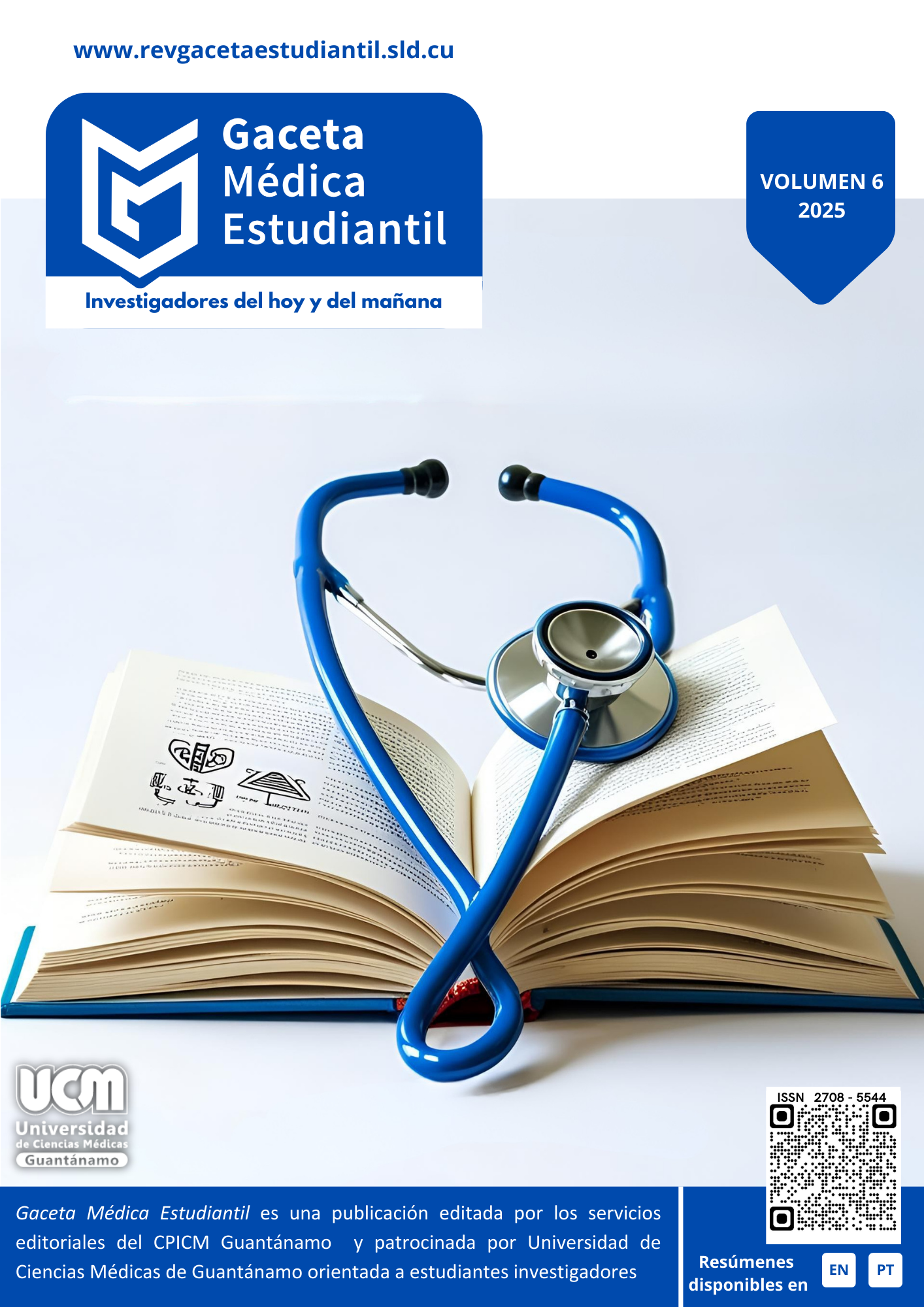Rol de los microorganismos en el síndrome de autofermentación intestinal
Palabras clave:
síndrome de autodestilación alcohólica, diagnóstico, etanol, Fermentación endógena de alcoholResumen
Introducción: la viroterapia oncolítica se ha establecido como una táctica terapéutica en auge en la inmunoterapia contra el cáncer, empleando virus alterados genéticamente para tratar únicamente las células malignas sin perjudicar el tejido saludable. Objetivo: identificar los microorganismos orales presentes en el desarrollo del síndrome de autodestilación alcohólica. Método: se realizó una revisión bibliográfica mediante artículos artículos científicos de tipo revisión bibliográfica, reportes de caso y un estudio de casos y controles, tomando en cuenta que la publicación de los mismos sean dentro del rango 2018-2024. Desarrollo: el tratamiento principal para el SAA se enfoca en el uso de antimicóticos en donde el fluconazol oral 100-150 mg durante 14 días suele ser la primera elección en estos casos. Sin embargo, ante la resistencia al fluconazol se administró junto nistatina 50.000 UI tres veces durante 10 días. Adicionalmente incluye la alternativa del uso de micafungina 150 mg IV en casos de que la terapia oral no funcione. Conclusiones: la presente indagación ha puesto de manifiesto la relación entre los microorganismos orales y el SAA, corroborada por diversos reportes de caso que han confirmado la influencia decisiva de estos agentes en la patogénesis del síndrome. Notablemente, se ha documentado que Saccharomyces cerevisiae emerge con mayor frecuencia como el microorganismo predominante
Descargas
Citas
1. Halim S, López V, Gavilanes J, Portilla P, Rodríguez M, Cortés D, et al. Síndrome de autodestilación alcohólica Un desafío diagnóstico. Acta Médica Colombiana. 2023; 48(1). Disponible en: https://www.actamedicacolombiana.com/ojs/index.php/actamed/article/view/2565
2. Pandurangaiah R, HC M, Ambika H, Preetham R, Kameswari K, Kumar P, et al. Effect of Auto Brewery Syndrome in general and Oral Health Systematic Review and Meta analysis. Annals of R.S.C.B. 2021; 25(6): p. 11423-11430. Disponible en: http://annalsofrscb.ro/index.php/journal/article/view/7653/5676
3. Olivera R. The Auto-Brewery Syndrome: A Perfect Metabolic “Storm” with Clinical and Forensic Implications. Journal of Clinical Medicine. 2021; 10(20). Disponible en: https://www.mdpi.com/2077-0383/10/20/4637
4. Smedra A, Trzmielak M, Góralska K, Dzikowiec M, Brzeziańska E, Berent J. Oral form of auto-brewery syndrome. Journal of Forensic and Legal Medicine. 2022; 87. Disponible en: https://www.sciencedirect.com/science/article/abs/pii/S1752928X22000312
5. Smedra A, Berent J. The Influence of the Oral Microbiome on Oral Cancer: A Literature Review and a New Approach. MDPI. 2023; 13(5). Disponible en: https://www.mdpi.com/2218-273X/13/5/815
6. Malik F, Wickremesinghe P, Saverimuttu J. Case report and literature review of auto-brewery syndrome: probably an underdiagnosed medical condition. BMJ Journals. 2023; 6(1). Disponible en: https://bmjopengastro.bmj.com/content/6/1/e000325#T1
7. Paramsothy J, Gutlapalli SDPV, Okorie I, Ugwendum D, Piccione G, Ducey J, et al. Understanding Auto-Brewery Syndrome in 2023: A Clinical and Comprehensive Review of a Rare Medical Condition. Cureus. 2023; 15(4). Disponible en: https://www.ncbi.nlm.nih.gov/pmc/articles/PMC10189828/
8.
9. Akhavan BJ, Ostrosky Zeichner L, Thomas EJ. Drunk Without Drinking: A Case of Auto-Brewery Syndrome. ACG Case Report Journal. 2019; 6(9). Disponible en: https://journals.lww.com/acgcr/fulltext/2019/09000/drunk_without_drinking__a_case_of_auto_brewery.14.aspx?WT.mc_id=HPxADx20100319xMP
10. Bayoumy AB, Mulder C, Jaap J, Tushuizen ME. Gut fermentation syndrome: A systematic review of case reports. UEG Journal. 2021; 9(3). Disponible en: https://onlinelibrary.wiley.com/doi/10.1002/ueg2.12062
11. Zewude RT, Croitoru K, Das R, Goldman B, Isaac B. Auto-brewery syndrome in a 50-year-old woman. Cmaj. 2024; 196(21). Disponible en: https://www.cmaj.ca/content/196/21/E724
12. Tameez A, Alam F, Tameez A, Mohyud F. Auto-Brewery Syndrome: A Clinical Dilemma. Cureus. 2020; 12(10). Disponible en: https://www.ncbi.nlm.nih.gov/pmc/articles/PMC7667719/
13. Takahashi G, Hoshikawa K, Kan S, Akimaru R, Kodama Y, Sato T, et al. Auto-brewery syndrome caused by oral fungi and periodontal disease bacteria. Acute Medicine & Surgey. 2021; 8(1). Disponible en: https://onlinelibrary.wiley.com/doi/full/10.1002/ams2.652
14. Saverimuttu J, Malik F, Arulthasan M, Wickremesinghe P. A Case of Auto-brewery Syndrome Treated with Micafungin. Cureus. 2019; 11(10). Disponible en: https://www.cureus.com/articles/23443-a-case-of-auto-brewery-syndrome-treated-with-micafungin#!/
15. Vandekerckhove E, Janssens F, Tate D, De Looze D. Treatment of Gut Fermentation Syndrome With Fecal Microbiota Transplantation. Ann Intern Med. 2020; 173(10). Disponible en: https://www.acpjournals.org/doi/10.7326/L20-0341
16. Ahmed S, Wickremesinghe P, Kopetz V, Sarkar S. A Rare Diagnosis of Gut Fermentation/Auto-Brewery Syndrome in the Setting of Diabetes and Obesity. American Journal of Clinical Pathology. 2018; 150(1). Disponible en: https://academic.oup.com/ajcp/article/150/suppl_1/S2/5102922
17. Xue G, Feng J, Zhang R, Du B, Sun Y, Liu S, et al. Three Klebsiella species as potential pathobionts generating endogenous ethanol in a clinical cohort of patients with auto-brewery syndrome: a case control study. eBioMedicine. 2023; 91. Disponible en: https://www.ncbi.nlm.nih.gov/pmc/articles/PMC10139882/#appsec1
18. Alduraywish A. Case Report: Diabetic urinary auto-brewery and review of literature. F1000Res. 2021; 10(407). Disponible en: https://www.ncbi.nlm.nih.gov/pmc/articles/PMC8886172/
19. Akbaba M. A medicolegal approach to the very rare Auto-Brewery (endogenous alcohol fermentation) syndrome. Traffic Inj Prev. 2020; 21(5): p. 295-297. Disponible en: https://pubmed.ncbi.nlm.nih.gov/32255712/
20. Mbaye B, Borentain P, Magdy R, Tijdani M, Armstrong N, Motolla G, et al. Producción endógena de etanol y triglicéridos por las levaduras intestinales Pichia kudriavzevii , Candida albicans y Candida glabrata en la esteatohepatitis no alcohólica. Cells. 2022; 11(21). Disponible en: https://www.mdpi.com/2073-4409/11/21/3390#B16-cells-11-03390
21. Tamama K, Kruckenberg K, DiMartini A. Gut and bladder fermentation syndromes. BMC Medicine. 2024; 22(26). Disponible en: https://bmcmedicine.biomedcentral.com/articles/10.1186/s12916-023-03241-7
Descargas
Publicado
Cómo citar
Número
Sección
Licencia

Esta obra está bajo una licencia internacional Creative Commons Atribución-NoComercial 4.0.
La revista Gaceta Médica Estudiantil proporciona un Acceso Abierto inmediato a su contenido. Es publicada bajo una licencia Creative Commons Reconocimiento-NoComercial 4.0 Internacional (CC BY-NC) que permite compartir (copiar y redistribuir el material en cualquier medio o formato) y adaptar (remezclar, transformar y crear a partir del material), bajo las condiciones de reconocer la autoría y no hacer uso comercial de los materiales.












